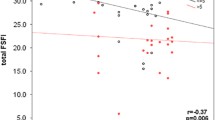Summary
Objectives: Fibromyalgia syndrome (FMS) is a chronic pain disorder, where 90% of the patients struck by the disorder are women. The neuropeptide oxytocin is known to have antinociceptive and analgesic, as well as anxiolytic and antidepressant effects, which makes this neuropeptide of interest in fibromyalgia research. The aim of this study was to assess oxytocin concentrations in female FMS patients with different hormonal status and in depressed and non-depressed patients and relate oxytocin concentrations to adverse symptoms as pain, stress, depression, anxiety and to the positive item happiness.¶ Methods: Thirty-nine patients and 30 controls registered these symptoms daily during 28 days and blood samples for the assessment of oxytocin were drawn twice in all patients and controls. Besides the daily ratings, depression was also estimated with the self-rating instrument Beck Depression Inventory (BDI).¶ Results: Depressed patients according to the BDI differed significantly with low levels of oxytocin compared to the non-depressed patients and the controls. Low levels of oxytocin were also seen in high scoring pain, stress and depression patients according to the daily ratings; however, these subgroups were small. A negative correlation was found between the scored symptoms depression and anxiety and oxytocin concentration, and a positive correlation between the item happiness and oxytocin. The oxytocin concentration did not differ between the hormonally different subgroups of patients or controls.¶ Conclusion: The results suggest that the neuropeptide oxytocin may, together with other neuropeptides and neurotransmitters, play a role in the integration of the stress axes, monoaminergic systems and the pain processing peptides in the pathophysiologic mechanisms responsible for the symptoms in the FMS.
Zusammenfassung
Ziel: Das Fibromyalgie-Syndrom (FMS) ist eine durch Schmerzen gekennzeichnete chronische Erkrankung, bei der 90% der betroffenen Patienten Frauen sind. Das Neuropeptid Oxytocin ist bekannt für seine antinozizeptive und analgetische wie auch seine anxiolytische und antidepressive Wirkung, weshalb diese Substanz von Interesse für die FMS-Forschung ist. Das Ziel dieser Untersuchung war es, die Konzentration von Oxytocin im Blut bei FMS-Patientinnen mit unterschiedlichem Hormonstatus sowie bei depressiven und nichtdepressiven Patientinnen zu messen, und die Oxytocin-Konzentration einerseits auf negative Symptome wie Schmerz, Stress, Depression und Angst, und andererseits auf den positiven Faktor Freude zu beziehen.¶ Methode: 39 Patientinnen und 30 Kontrollpersonen notierten diese Symptome täglich während 28 Tagen, und von allen Patientinnen und Kontrollpersonen wurden zweimal täglich Blutproben zwecks Bestimmung des Oxytocin-Plasmakonzentrationen entnommen. Neben dieser täglichen Erfassung geschah auch eine Registrierung von Depression mit Hilfe des Selbsteinschätzungsinstrumentes Beck Depression Inventory (BDI).¶ Resultat: Depressive Patientinnen wiesen niedrige Werte für Oxytocin auf und unterschieden sich dadurch – entsprechend dem BDI – beträchtlich von nichtdepressiven Patientinnen und den Kontrollpersonen. Niedrige Oxytocin-Plasmakonzentrationen wurden auch bei starkem Schmerz und Stress sowie bei depressiven Patientinnen beobachtet. Diese Untergruppen waren allerdings klein. Festzustellen war eine negative Korrelation zwischen den gemessenen Symptomen Depression und Angst und der Oxytocin-Konzentration, eine positive zwischen dem Faktor Freude und Oxytocin. Zwischen den in hormoneller Hinsicht unterschiedlichen Untergruppen von Patientinnen oder Kontrollpersonen bestand kein Unterschied der Oxytocin-Konzentration im Blut.¶ Zusammenfassung: Die Resultate deuten darauf hin, dass das Neuropeptid Oxytocin, zusammen mit anderen Neuropeptiden und Neurotransmittern, eine Rolle spielt in der Integration der Stressachsen, der monoaminergen Systeme und der schmerzregulierenden Peptide in den pathophysiologischen Mechanismen, die für die Symptome bei FMS verantwortlich sind.
Similar content being viewed by others
Author information
Authors and Affiliations
Additional information
Received: 23 March 2000/Accepted: 29 August 2000
Rights and permissions
About this article
Cite this article
Anderberg, U., Uvnäs-Moberg, K. Plasma oxytocin levels in female fibromyalgia syndrome patients. Z Rheumatol 59, 373–379 (2000). https://doi.org/10.1007/s003930070045
Issue Date:
DOI: https://doi.org/10.1007/s003930070045




